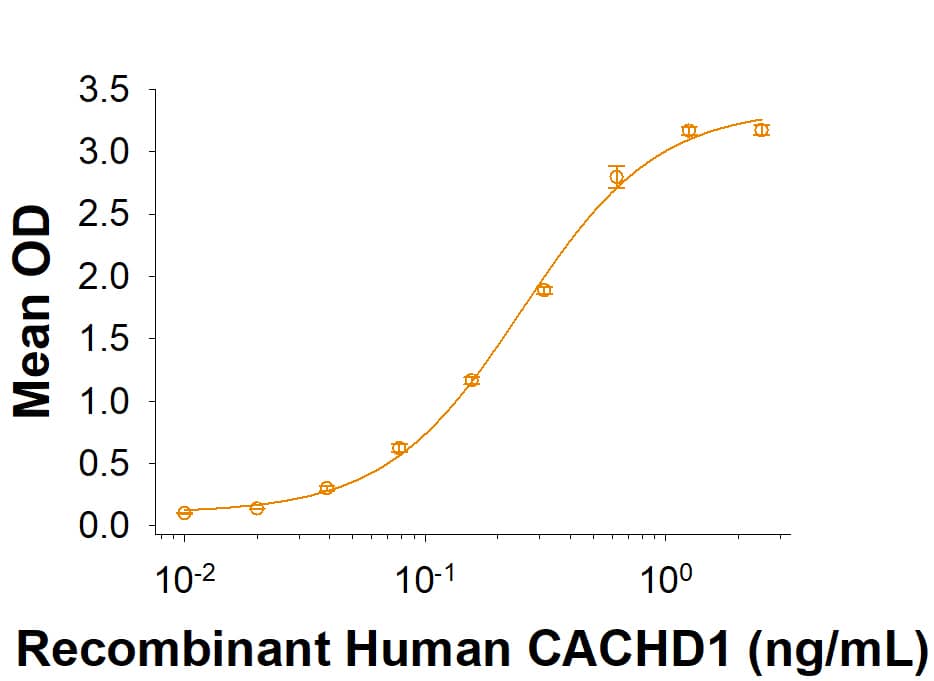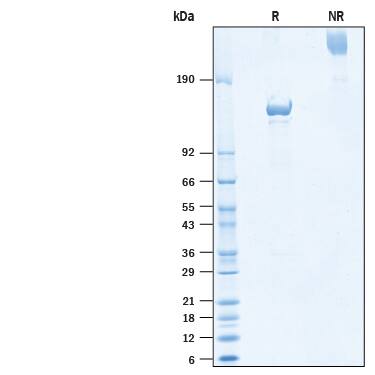Recombinant Human CACHD1 Fc Chimera Protein, CF Summary
Product Specifications
| Human CACHD1 (Glu36-Pro1095) Accession # Q5VU97.2 | IEGRMD | Human IgG1 (Pro100-Lys330) |
| N-terminus | C-terminus | |
Analysis
Product Datasheets
Carrier Free
CF stands for Carrier Free (CF). We typically add Bovine Serum Albumin (BSA) as a carrier protein to our recombinant proteins. Adding a carrier protein enhances protein stability, increases shelf-life, and allows the recombinant protein to be stored at a more dilute concentration. The carrier free version does not contain BSA.
In general, we advise purchasing the recombinant protein with BSA for use in cell or tissue culture, or as an ELISA standard. In contrast, the carrier free protein is recommended for applications, in which the presence of BSA could interfere.
10749-CA
| Formulation | Lyophilized from a 0.2 μm filtered solution in PBS. |
| Reconstitution | Reconstitute at 500 μg/mL in PBS. |
| Shipping | The product is shipped at ambient temperature. Upon receipt, store it immediately at the temperature recommended below. |
| Stability & Storage: | Use a manual defrost freezer and avoid repeated freeze-thaw cycles.
|
Scientific Data
 View Larger
View Larger
Recombinant Human CACHD1 Fc Chimera (Catalog # 10749-CA) binds Recombinant Human/Mouse Wnt-5a Biotinylated Protein (BT645). The ED50 for this effect is 0.08-0.640 μg/mL.
 View Larger
View Larger
2 μg/lane of Recombinant Human CACHD1 Fc Chimera Protein (Catalog # 10749-CA) was resolved with SDS-PAGE under reducing (R) and non-reducing (NR) conditions and visualized by Coomassie® Blue staining, showing bands at 133-147 kDa and 260-300 kDa, respectively.
Reconstitution Calculator
Background: CACHD1
CACHD1 (Ca2+ channel and chemotaxis receptor Domain Containing 1) is a alpha 2δ-Like Protein that modulates CaV3 voltage‑gated calcium channel activity (1, 2). Mature Human CACHD1 consists of a 1060 amino acid (aa) extracellular domain (ECD), a 21 aa transmembrane segment, and a 158 aa cytoplasmic domain. The ECD contains a von Willebrand factor A (VWA) domain and two bacterial chemosensory-like cache domains (1). Within the ECD, human CACHD1 shares 97.5% and 97.7% aa sequence identity with mouse and rat CACHD1, respectively. Diseases associated with CACHD1 include Cercarial Dermatitis and Hypertropia. CACHD1 increases the presence of CaV3.1 at the cell surface and causes an increase in channel open probability (2). CACHD1 is a new activity-modifying protein for voltage‑gated calcium channels (2). Such physiological actions may have implications in targeting diseases involving aberrant neuronal firing, as CaV3 channels have been proposed as therapeutic targets to combat pain and epilepsy (2). CACHD1 and MDGA1 are novel in vivo substrates for beta-site APP cleaving enzyme 1 (BACE1), suggesting that cleavage of both proteins may contribute to the numerous functions of BACE1 in the nervous system (3). BACE1 inhibition is a major therapeutic approach for Alzheimer disease (3). CACHD1 closely interacts with voltage‑gated calcium channels of the N-type58 and T-type59 at the cell surface and enhances the densities of their calcium currents (3). BACE1 cleavage is a mechanism to control CACHD1's function in calcium signaling and synaptic transmission (3). Expression of CACHD1 increased both CaV2.2 currents and cell surface trafficking in both cell lines and neurons (4). CACHD1 competed with a2d-1 for binding to CaV2.2 and for its functional effects and can therefore inhibit responses to a2d-1 (4). CACHD1 is widely expressed in many tissues, including the brain, lungs, and small intestine (4). CACHD1 contains a VWA domain that has a disrupted metal ion-dependent adhesion site (MIDAS) motif, a sequence that is conserved in the human, rat, mouse, and zebrafish CACHD1 proteins (4). At the Wnt Signaling Gordon Conference in August 2019, Yvonne Jones (Oxford) presented an unpublished crystal structure of the transmembrane proteins CACHD1 in a complex between LRP6 and Fz5. Their data suggest that CACHD1 is an inhibitor of Wnt signaling.
- Cottrell, G.S. et al. (2018) J. Neurosci. 38:9186.
- Stephens, G.J. and G.S. Cottrell (2019) Channels (Austin) 13:120.
- Njavro, J.R. et al. (2020) The FASEB J. 34:2465.
- Dahimene, S. et al. (2018) Cell Reports 25:1610.
FAQs
No product specific FAQs exist for this product, however you may
View all Proteins and Enzyme FAQsReviews for Recombinant Human CACHD1 Fc Chimera Protein, CF
There are currently no reviews for this product. Be the first to review Recombinant Human CACHD1 Fc Chimera Protein, CF and earn rewards!
Have you used Recombinant Human CACHD1 Fc Chimera Protein, CF?
Submit a review and receive an Amazon gift card.
$25/€18/£15/$25CAN/¥75 Yuan/¥2500 Yen for a review with an image
$10/€7/£6/$10 CAD/¥70 Yuan/¥1110 Yen for a review without an image
